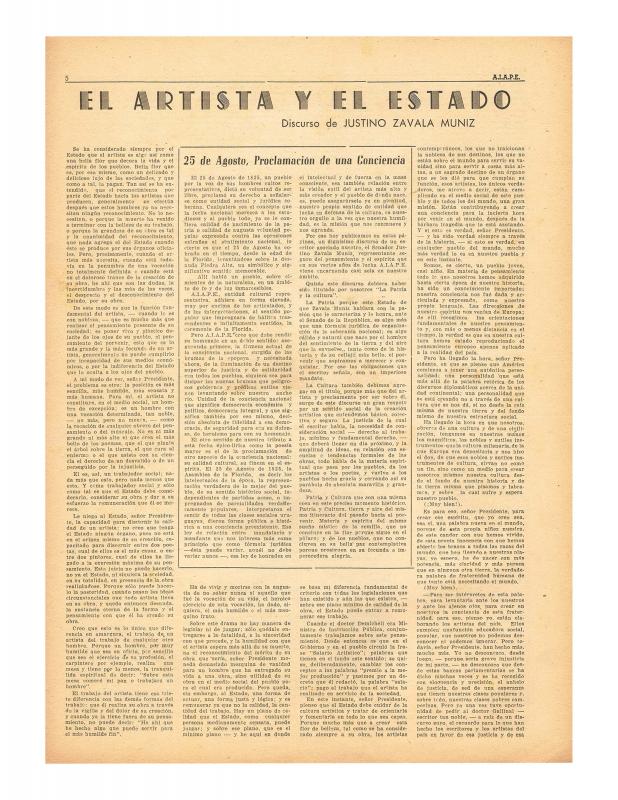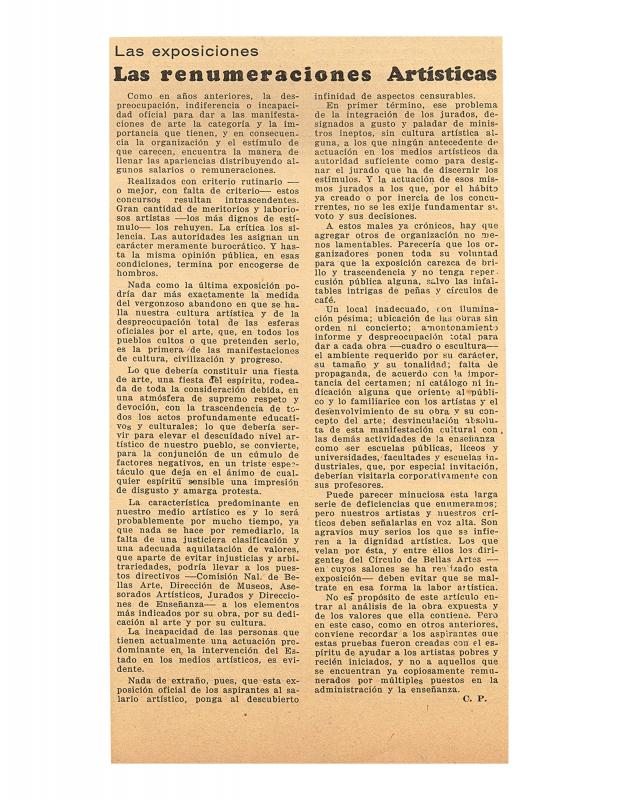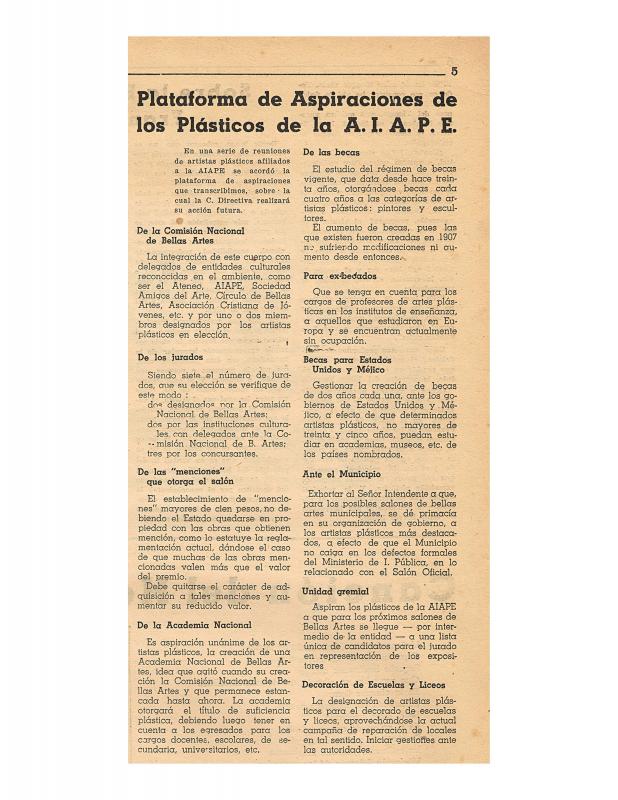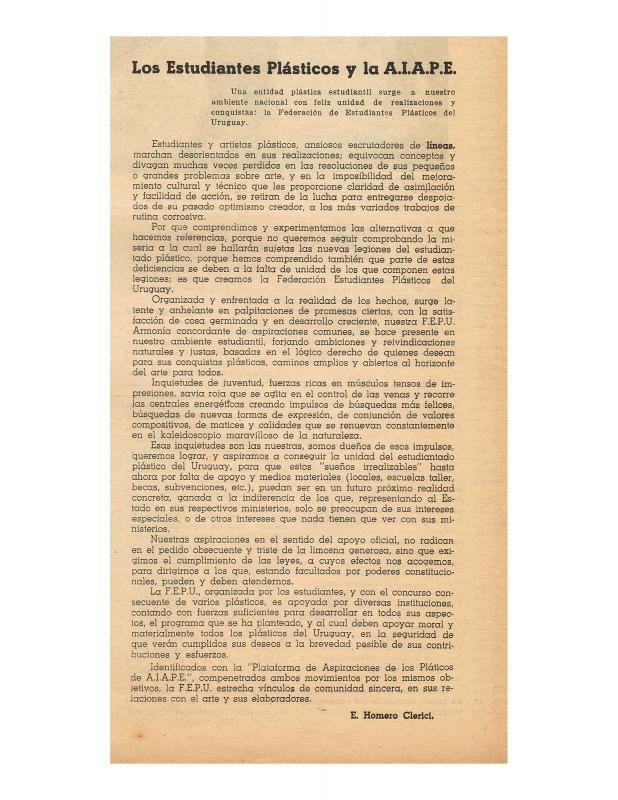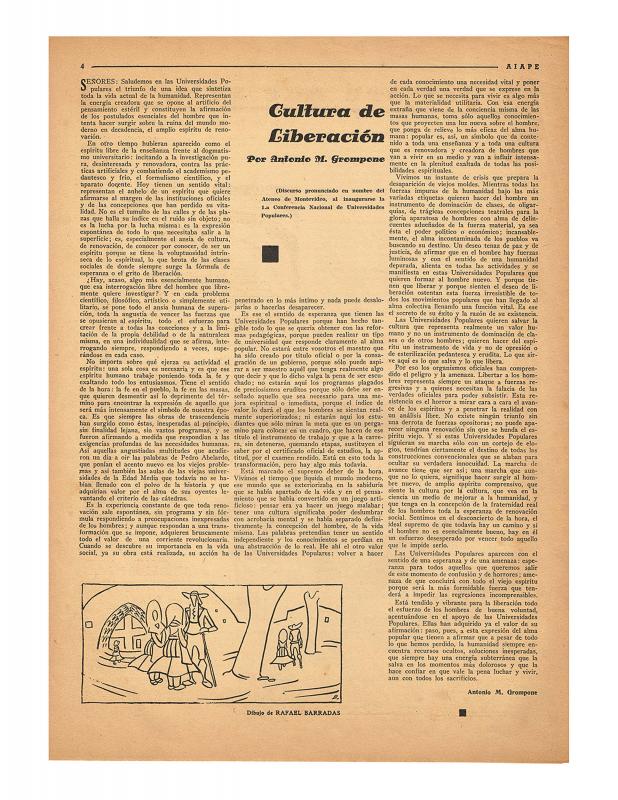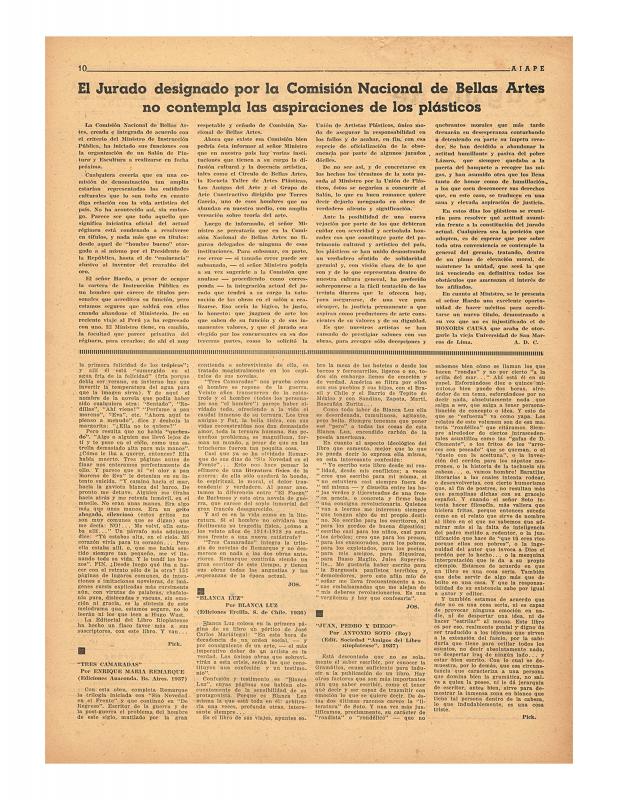In the early twentieth century, most Uruguayan visual artists’ organizations had a very broad range of interests in common. There were also, however, a number of areas where they did not all see eye to eye, such as rivalries between salons and competitions, the embrace of certain aesthetic movements, affiliations with various political ideologies, and so on. Some of these issues brought groups together, others drove them apart. In the late 1930s Uruguayan salons and art competitions with prizes were organized and judged by juries drawn from the political milieu allied with the dictator Gabriel Terra. Conservative art styles (which were encouraged by local salons) were rejected by artists who had trained in the modernist movement. Several groups and associations emerged at that time, such as the CTIU (Confederación de Trabajadores Intelectuales de Uruguay) which had a committee of visual artists; the AIAPE (Agrupación de Intelectuales, Artistas, Periodistas y Escritores); and the FEPU (Federación de Estudiantes Plásticos de Uruguay), all of which were anti-establishment to one degree or another. Against this backdrop, the Comisión Municipal de Cultura was created as an agency of the government of Montevideo, the capital city, in order to stimulate artistic activities from a different (if not openly opposed) perspective than the one endorsed by the national government, which controlled the Salón Nacional de Bellas Artes. For its part the AIAPE (founded in 1936 as an anti-fascist, pacifist association) wanted to support the Comisión Municipal in order to create a space for artists that was not being provided by the national government. The exhibition-fundraiser that was organized in support of the Chilean people thus had two objectives. One of them was to send a signal of support to the Frente Popular de Chile (under the presidency of Pedro Aguirre Cerda); the other was to expand the scope of the AIAPE by creating links with State agencies such as the Comisión de Cultura, which was working on presenting its first exhibition of visual art. 1939 was undoubtedly a landmark year in the history of the AIAPE. [As complementary reading see, in the ICAA digital archive, the following articles published in AIAPE: by Joaquín Torres García, “La exposición. [Amigos de España]” (doc. no. 1191197), “El Arte de Arzádum” (doc. no. 1223148), and “El arte de David Alfaro Siqueiros” (doc. no. 1238628); by Cipriano S. Vitureira, “1er Salón Municipal de Artes Plásticas/Su contenido artístico” (doc. no. 1184568), and “La pintura de Miguel Ángel Pareja” (doc. no. 1223795). See also the following: by Justino Zavala Muniz, “El artista y el Estado” (doc. no. 1216580); “Arte simple,” by Atahualpa del Cioppo (doc. no. 1223119); by Carmelo de Arzadum, “Las artes plásticas de 1936 a 1939” (doc. no. 1224706), and “Urruchúa (doc. no. 1224405); by Roberto Ibáñez (editor in chief), “Demetrio Urruchúa con Nosotros” (doc. no. 1223661), “Las exposiciones. Las remuneraciones artísticas” (doc. no. 1225449), “Los jurados del próximo Salón Nacional de Bellas Artes” (doc. no. 1225548), “Michelena- Escultor” (doc. no. 1223386), and “Plataforma de aspiraciones de los plásticos de la A.I.A.P.E.” (doc. no. 1225398); by Homero Clerici, “Los estudiantes plásticos y la AIAPE [Agrupación de Intelectuales, Artistas, Periodistas, y Escritores]” (doc. no. 1225286); by Felipe Novoa “El grabador Carlos González” (doc. no. 1223870); by Gisleno Aguirre, “La nueva Asociación de Artistas Plásticos” (doc. no. 1225166); by Orestes Baroffio, “Objeto y Significación de Un Salón de Arte” (doc. no. 1210990); and by C.L., “Teseo: los problemas del arte” (doc. no. 1223765). There were also many anonymous articles published in AIAPE: “Temas de discusión sobre la cultura Americana” (doc. no. 1225812), “La actividad plástica del año” (doc. no. 1223617); “Alianza de intelectuales, artistas y escritores bolivianos” (doc. no. 1225763); “El arte mejicano” (doc. no. 1225519); “Bases A.I.A.P.E (Agrupación de Intelectuales, Artistas, Periodistas y Escritores)” (doc. no. 1226697); “Cae decorado de Berni bajo la piqueta del G.O.U” (doc. no. 1225213); “Cultura de liberación” (doc. no. 1226424); “Cultura en el orden internacional” (doc. no. 1223996); “La ética social del artista,” unformatted (doc. no. 1223962); “Fuera del Salón Oficial” (doc. no. 1221528); “El jurado designado por la Comisión Nacional de Bellas Artes no contempla las aspiraciones de los plásticos” (doc. no. 1225373); “Los jurados de los salarios artísticos de 1935 atentó contra la cultura” (doc. no. 1225596); “La libertad en Portinari” (doc. no. 1225346); “El mensaje de Antonio Berni” (doc. no. 1223596); “Notas editoriales e informativas” (doc. no. 1226398); “Noticia de David Alfaro Siqueiros” (doc. no. 1223640); “Una opinión sobre el 6° Salón Nacional” (doc. no. 1225722); “Optimismo sobre España” (doc. no. 1225185); “Página de crítica y polémica. Las exposiciones” (doc. no. 1221503); “La pintura en el V Salón de Otoño” (doc. no. 1225672); “Reconocimiento a Élie Faure” (doc. no. 1223458); “VIII Salón Nacional de Bellas Artes” (doc. no. 1211227); and “Sobre la querella del realismo” (doc. no. 1225636)].






